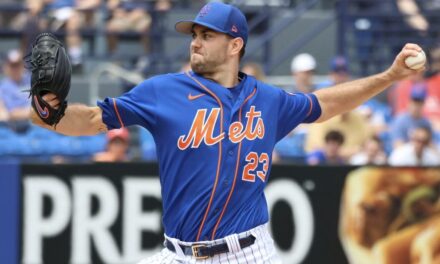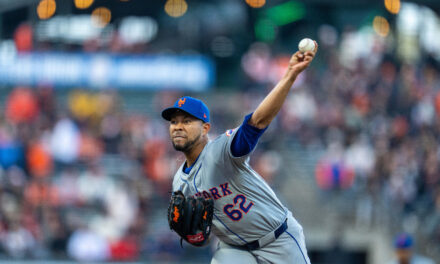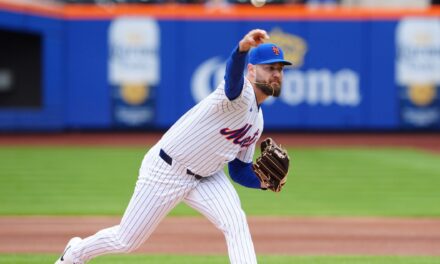Kevin Goldstein of Baseball Prospectus selected his Mets Top 11 Prospects and leading the pack is Jenrry Mejia.
Here is what he had to say about his top three selections.
1. Jenrry Mejia, RHP
Year in Review: A power right-hander, Mejia surprised many by making the big-league bullpen out of spring training, but returned to the minors to be developed as a starter in the second half following a bout of shoulder soreness.
The Good: Mejia has pure power stuff. He generates both strikeouts and plenty of ground balls with a heavy 94-97 mph fastball that features natural sinking action. He’ll flash a plus power curveball, but his changeup is his best secondary offering, with plenty of deception and late fade. His wide shoulders and thick lower half give scouts fewer concerns then they have for most shorter-than-average pitchers.
The Bad: There are some concerns about Mejia’s ability to handle a full-season workload, as he’s missed considerable time each of the last two years and has yet to cross the triple-digit hump as far as innings. He can fall in love with his fastball and needs to work more on pitch sequencing as opposed to just blowing every hitter away. His velocity comes with some effort, and he can overthrow and lose his command.
Perfect World Projection: Mejia has the stuff to pitch toward the front of a rotation, and that’s where the Mets will try to develop him from here on out.
Path to the Big Leagues: The most important thing for Mejia is innings, and he’ll get those as the ace of the Triple-A Buffalo rotation, with the Mets hoping he can return for a September call up in preparation for a 2012 rotation spot.
ETA: Late 2011.
2. Matt Harvey, RHP
Year in Review: Seen as a potential elite pick three years ago, Harvey saved his draft status with a strong junior year of college.
The Good: Harvey has a nearly perfect pitcher’s frame and the stuff to go with it. His low-to-mid-90s fastball is a dominant offering, and he was clocked as high as 98 mph last spring. He gets good spin on a power breaking ball that gives him a second plus offering when he’s on. He’s unflappable on the mound and earns praise for his aggressive pitching style.
The Bad: Harvey struggled with his mechanics in college, and his multi-part delivery leads to inconsistent release points, which leads to corresponding control issues. His changeup is a below-average pitch that will need coaching and consistent work. He has no history of arm issues, but shouldered a heavy workload last spring.
Perfect World Projection: Harvey has star potential, but with his inconsistent track record, it comes with a healthy dose of risk.
Path to the Big Leagues: Harvey is advanced enough to begin his pro career at High-A St. Lucie, and he’s talented enough to be at Double-A by season’s end.
ETA: 2013.
3. Wilmer Flores, SS
Year in Review: The best pure hitter in the system proved himself at both A-levels as a teenager.
The Good: Flores can hit, period. With plenty of bat speed, strong wrists, and outstanding hand-eye coordination, he consistently puts the fat part of the bat on the ball and uses all fields. He projects for average-to-plus power down the road, and showed some signs in 2010 of learning how to recognize pitches he can drive. He has very good defensive fundamentals and an above-average arm.
The Bad: It’s impossible to find any talent evaluator who believes Flores can remain up the middle. He’s already a below-average runner, and his lower half continues to thicken. He has the tools to play third base, but will need to fill out his power projection to be an above-average player there. His hitting ability gets the better of him at times, as he can become an inpatient hacker at times.
Perfect World Projection: He’s going to hit, but where he ends up defensively will ultimately define his value.
Path to the Big Leagues: Still just 19, there’s no need to rush Flores. He’ll return to High-A in 2011, but could move up once the weather warms if he’s still hitting.
ETA: 2013.
4. Cesar Puello, OF
5. Kirk Nieuwenhuis
6. Reese Havens, 2B
7. Fernando Martinez, OF
8. Aderlin Rodriguez, 3B
9. Cory Vaughn, OF
10. Lucas Duda, 1B/OF
11. Darrell Ceciliani, OF
In his summary, Goldstein writes,
Neither great, nor awful, the Mets’ organization is a middle-of-the-road one that provides more long-term bets than immediate assistance to the big-league squad.
To read a full analysis on each player, plus who rounds out the Mets Top 20 go read the rest of Kevin Goldstein’s article at Baseball Prospectus.














